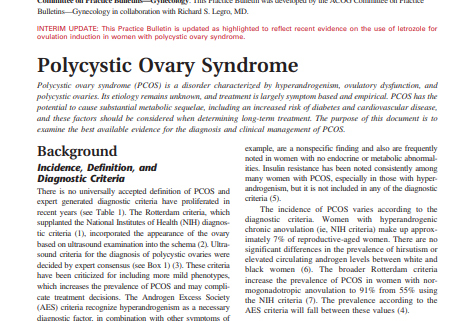POLYCYSTIC OVARY SYNDROME
Polycystic ovary syndrome (PCOS) is a disorder characterized by hyperandrogenism, ovulatory dysfunction, and polycystic ovaries. Its etiology remains unknown, and treatment is largely symptom based and empirical. PCOS has the potential to cause substantial metabolic sequelae, including an increased risk of diabetes and cardiovascular disease, and these factors should be considered when determining long-term treatment. The purpose of this document is to examine the best available evidence for the diagnosis and clinical management of PCOS.
Background
Incidence, Definition, and Diagnostic Criteria
There is no universally accepted definition of PCOS and expert-generated diagnostic criteria have proliferated in recent years (see Table 1). The Rotterdam criteria, which supplanted the National Institutes of Health (NIH) diagnostic criteria (1), incorporated the appearance of the ovary based on ultrasound examination into the schema (2). Ultrasound criteria for the diagnosis of polycystic ovaries were decided by expert consensus (see Box 1) (3). These criteria have been criticized for including more mild phenotypes, which increases the prevalence of PCOS and may complicate treatment decisions. The Androgen Excess Society (AES) criteria recognize hyperandrogenism as a necessary diagnostic factor, in combination with other symptoms of the syndrome (4). Hyperandrogenism can be established on the basis of clinical findings (eg, hirsutism or acne) or serum hormone measurement. All diagnostic approaches recommend that secondary causes (such as adult-onset congenital adrenal hyperplasia, hyperprolactinemia, and androgen-secreting neoplasms) should first be excluded.



